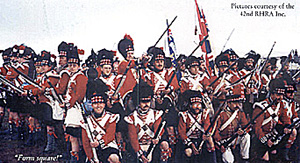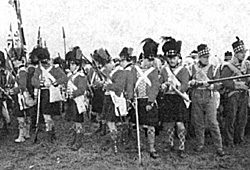 This article is written by John Haskell, who is the Vice President of the 42nd Royal Highland Regiment Australia (1815) Inc. He went to Belgium in 1995 to take part in the Reenactment of the Battle of Waterloo. This event is normally held every five years.
This article is written by John Haskell, who is the Vice President of the 42nd Royal Highland Regiment Australia (1815) Inc. He went to Belgium in 1995 to take part in the Reenactment of the Battle of Waterloo. This event is normally held every five years.
How it started…
The trip to Waterloo arose through a series of fortuitous meetings. In 1993/4 the 42nd Royal Highland Regiment 1815 in the UK sent out a series of invitations to various people around the world to attend a battle re enactment to be staged at Waterloo in Belgium. The first such re enactment occurred in 1990. These invitations also appeared in the US publication, "Civil War Times."
Details were sought about attending the event and eventually five men and two women from Australia joined the 42nd in the UK in order to attend the event. Thorough research was undertaken to build up an accurate set of uniforms and accoutrements for a Centre Company impression circa 1815. The women dressed as camp followers of the period. When all that had been completed it was time for the fun to begin. Red tape consisting of firearm permits to enter England and re enter Australia were sought from the various authorities.
In England you cannot bring a firearm into the country without a sponsor who can guarantee you will abide by their legislation. We had undertakings from a firearm retailer in England from whom we had agreed to hire Brown Bess muskets from, to act as our sponsors. This we decided was the easier option, rather than take our own firearms overseas.
We also obtained application permits for a black powder licence. This enables you to posses and use black powder in the UK. Entry visas were sought to enter France as we had to travel through France to get to Belgium. We all joined the 42nd UK and the Napoleonic Association in England to facilitate our transport and accommodation at Waterloo.
This also covered us for public risk insurance over there. We paid a nominal figure to the Napoleonic Association to cover us for transport costs and accommodation in Europe
The big day drew closer.
Six weeks prior to our departure we learnt that our firearm sponsor in England had withdrawn their willingness to provide us with muskets and the necessary paperwork. As it was too close to departure time to arrange another source of muskets or to arrange the transport of our own, we were devastated. One of our number in Western Australia, Richard Stein (now President of the 42RHRA), contacted a theatrical hire company in England to arrange the hire of muskets. Because of our lack of licences we had to make do with fibreglass non firing props. We were told these looked like the real thing. The muskets would be delivered to Richard at his hotel in Rochester the night before departing Fort Amherst.
As we came from all over Australia we had little time or opportunity to meet up prior to the trip, we had arranged to meet up in the car park of Fort Amherst in Chatum on the 16th June 1995. This was the Friday morning and the day of departure for Waterloo, the Napoleonic Association had organised coaches to transport all the re enactors to the battle site at Waterloo. The day dawned overcast and very humid, we all arrived at the fort car park and made ourselves known to the 42nd UK commander. This was the first time all the Australians had gathered together. All of us belonged to various re-enactment groups in Australia but only a few of us had met before.
 Richard handed out the rented muskets which we quickly
stowed along with the rest of our kit in our allocated coach.
We were to be travelling with the 42nd Royal Highland
Regiment UK (42RHRUK). We departed Chatum and
headed for Ramsgate where we were to board a ferry to travel across the channel.
Richard handed out the rented muskets which we quickly
stowed along with the rest of our kit in our allocated coach.
We were to be travelling with the 42nd Royal Highland
Regiment UK (42RHRUK). We departed Chatum and
headed for Ramsgate where we were to board a ferry to travel across the channel.
I cannot describe the scene in the Ferry terminal car park. It looked like "D-day" 1815 with red coated soldiers everywhere. Nine pounder guns on trailers surrounded by huge piles of equipment, with buses, cars everywhere. All that was needed was a naval captain at the helm of the Ferry.
The channel crossing was uneventful, we used the money exchange service on the ferry to convert some of our English money into Francs. We entered France via Dunkirk. It was a sobering sight to see the still visible shrapnel and bullet scars on the buildings at Dunkirk. It is one thing to read about the second world war, it is quite another to be confronted with the physical evidence.
Our coach travelled through the French countryside heading for Belgium. Crossing the frontier into Belgium was like crossing the state borders here in Australia (only without the fruit fly warnings).
The Ville de (village of) Waterloo finally came into view ahead. We craned out of the windows to get a good view. Everywhere were the dreaded blue coated soldiers of Napoleon, as the coach passed through the streets, comments back and forth became rather ribald. The coach drove into the local secondary college, which we were led to believe was our billet for the weekend.
All around us the Napoleonic French Army paraded and drilled. The school the 42nd UK had used previously was now a French billet. Despite some of the looks directed at us, we were rather pleased with ourselves, you see, we knew who was going to win the upcoming battle. After some discussion we were directed to the village of Du Joine, some 30 kilometres away where we were billeted in a girls boarding school. It should be noted that in Europe this time is the height of summer holidays.
At this point the black powder was issued, with all troops loading paper cartridges in preparation for the battle. I believe there was just over a tonne of powder used by both participating sides on the day of the battle. This was issued and paid for by the Waterloo battle organisers which consisted of representatives of the various village councils and the television media.
Several of us attempted to find out the format of the battle the next day. We were surprised that the rank and file have very little knowledge of the scripted scenario. It appears the European groups are structured so that the Officers are aware of the whole scenario, the NCO's are instructed what to do by the Officers and they pass the information on to the troops. I doubt if that structure would work here in Australia. I know it frustrated us when we were trying to plan ahead.
We all settled in for the night, couples on one side and singles on the other. Our meal that night was taken at the local café, the language was a problem at first, school boy French does not help. Particularly if they think you are English. I found it strange to have women trying to look up my kilt. I now have a new perspective on the opposite sex.
 The next morning we were up bright and early. Breakfast was
held in the boarding school's dining rooms, we lined up for
croissants, eggs and bacon. We boarded the bus and headed
back to Waterloo. We formed up and proceeded to march
around many of the small villages in the area. At each town
hall we formed up for the Village Mayor, who gave an
appropriate speech before we moved on to the next town.
Parading through the streets as part of the British Brigade
was really huge thrill. The response from the people lining
the streets were enthusiastic, although the French brigade
brought forth the loudest cheers.
The next morning we were up bright and early. Breakfast was
held in the boarding school's dining rooms, we lined up for
croissants, eggs and bacon. We boarded the bus and headed
back to Waterloo. We formed up and proceeded to march
around many of the small villages in the area. At each town
hall we formed up for the Village Mayor, who gave an
appropriate speech before we moved on to the next town.
Parading through the streets as part of the British Brigade
was really huge thrill. The response from the people lining
the streets were enthusiastic, although the French brigade
brought forth the loudest cheers.
Stand down was called at mid afternoon, which gave us a short time to have a look around the village before lining up for a meal in a basketball stadium. There were approximately three thousand re-enactors in the stadium from all countries.
A party soon developed. The French sang stirring revolutionary songs, the English responded with the "British Grenadier". The Highlanders cleared the tables and marched up and down playing "Scotland The Brave". There were a group of Cossacks who were giving impromptu displays of sword "twirling". The night was one of the most memorable I can remember.
The Day of the Battle: June 18th 1995
Back to Table of Contents -- Kriegspieler #7
To Kriegspieler List of Issues
To MagWeb Master Magazine List
© Copyright 1999 by Kriegspieler Publications.
This article appears in MagWeb (Magazine Web) on the Internet World Wide Web.
Other military history articles and gaming articles are available at http://www.magweb.com